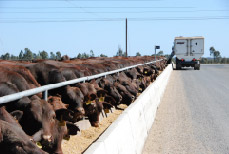This Beef Cattle Trait Is Measured by the Pounds of Feed Required Per Pound of Liveweight Gain
 The key variables affecting the profitability of feedlots are: shop cattle purchase cost; finished cattle sale cost; toll of feed consumed; and liveweight gain. This fact canvas deals with feed consumption and liveweight gain.
The key variables affecting the profitability of feedlots are: shop cattle purchase cost; finished cattle sale cost; toll of feed consumed; and liveweight gain. This fact canvas deals with feed consumption and liveweight gain.
Feed consumption
Bolt used in feedlot rations vary considerably in dry out thing content (DM). Hay and grain are approximately 90% DM, molasses 75% DM and silage 40% DM. A basic guide for estimating dry thing consumption of feedlot animals is to calculate two.vii% to 3.0% of their liveweight (in kilograms). Therefore, an animate being consuming a grain based diet of 90% DM, would take an estimated intake of fresh feed between 3.0% (2.7% x100/90) and 3.33% (three.0% x100/ninety) of their liveweight.
For instance, heavy steers destined for the Japanese brusque fed market accept an entry weight of approximately 450kg and a finished weight of 600kg, giving an average weight of 525kg.
Estimated daily fresh feed consumption (if consuming iii.0% of liveweight):
= (450 + 600)/2 ten (three.0/100) = 15.8kg
Full fresh feed consumption for 100 days:
= 15.8 ten 100 = 1,580kg
The dry affair content of a ration refers to the amount of dry textile available in a given ration. A number of factors influence the average daily dry thing consumption of lot-fed cattle. These include, liveweight (their required maintenance energy requirements), body condition, energy concentration of the ration, health status, and ration palatability.
Young animals and animals of lighter body condition may eat greater than three% of their body weight on a dry out matter basis as they have a higher maintenance energy requirement, while older animals and animals in meliorate body condition have a lower dry matter intake approximating 2.vii%.
The energy of a ration is measured in megajoules (MJ) of metabolisable free energy (ME) per kilogram of feed on a dry matter footing. Metabolisable energy content of a ration can as well upshot consumption, with extremes in ME content reducing consumption relative to the optimum ME content of the ration. Palatability of the ration also effects consumption. Very low DM content diets (less than 40%) tin can issue in reduced dry matter consumption.
Feedlot managers normally find that cattle in backward store condition (drought affected) demand to be held in the feedlot for extended periods to meet market requirements. However, these cattle frequently consume well over three% of their liveweight on a fresh feed basis and take exceptional liveweight gain. These fast gainers invariably have high feed conversion efficiency (liveweight proceeds: feed intake).
Liveweight gain
Variation in gut make full can have a big effect on liveweight proceeds and therefore must be minimised. The normal procedure with lot-fed cattle, if measuring for liveweight gain, is to weigh before the morning feed. This gives a benchmark time to work from, every bit initial induction weights are taken with little or no gut fill. Standard weighing procedures need to be adopted when determining liveweight gain.
In addition to gut make full, many other factors tin can outcome liveweight gain. The near important of these include age, sex, genetic merit, breed, body status, health status, nutrition composition, diet nutrient content, diet intake, growth promotant and previous nutritional history.
Noticeable variation occurs between animals in relation to an optimum stop signal. Older animals volition achieve optimum finish faster than younger animals, every bit these animals are nearing the end of their growth period and will partition most of their nutrient intake into finishing. Younger animals will sectionalization a proportion of their intake towards skeletal and muscle development. Because heifers mature earlier than steers, they will unremarkably finish sooner and may require closer supervision to avoid excess fat.
As a rule, European breeds grow faster than British or Zebu breeds and tend to be leaner, simply there tin can exist equally much variation within a breed as between breeds. There is a broad genetic variation in the power of animals to put on liveweight. As cattle finish, their rate of liveweight gain diminishes slightly. Health problems, whether it exist acidosis, respiratory illness or from other causes, tin be reflected in poor liveweight proceeds of private animals. Nutrient deficiency (energy, protein, minerals and vitamins) tin besides cause a reduction in liveweight gain.
Growth promotants and rumen modifiers accept proven to enhance liveweight gain. Any restriction in feed or h2o intake, causes a reduction in liveweight proceeds.
The following table is a guide to likely daily liveweight gains for a number of lot-feeding systems.
| Marketplace specification* | Average gain (kg/hd/day) | Range (kg/hd/day) |
|---|---|---|
| Domestic trade – steers | 1.iv | 1.1 to 1.seven |
| Domestic trade – heifers | i.three | 1.0 to 1.half-dozen |
| Korea | 1.5 | i.two to one.8 |
| Japan – short fed | 1.5 | 1.ii to 1.8 |
| Japan – long fed | 1.3 | 1.0 to one.6 |
*It is important to know the market specifications for finished cattle to determine the specifications of the store cattle inbound the feedlot.
The above information shows averages achieved for purchased store cattle, college gains may be achieved with ain cattle.
Further information
Contact the Department of Agriculture and Fisheries Customer Service Heart on 13 25 23 (Queensland residents) or 07 3404 6999 betwixt 8am and 6pm weekdays, or e-mail callweb@daf.qld.gov.au.
Sarah-Jane Forster, formerly Queensland Government.
Source: https://futurebeef.com.au/resources/beef-cattle-feedlots-feed-consumption-and-liveweight-gain/
0 Response to "This Beef Cattle Trait Is Measured by the Pounds of Feed Required Per Pound of Liveweight Gain"
Post a Comment